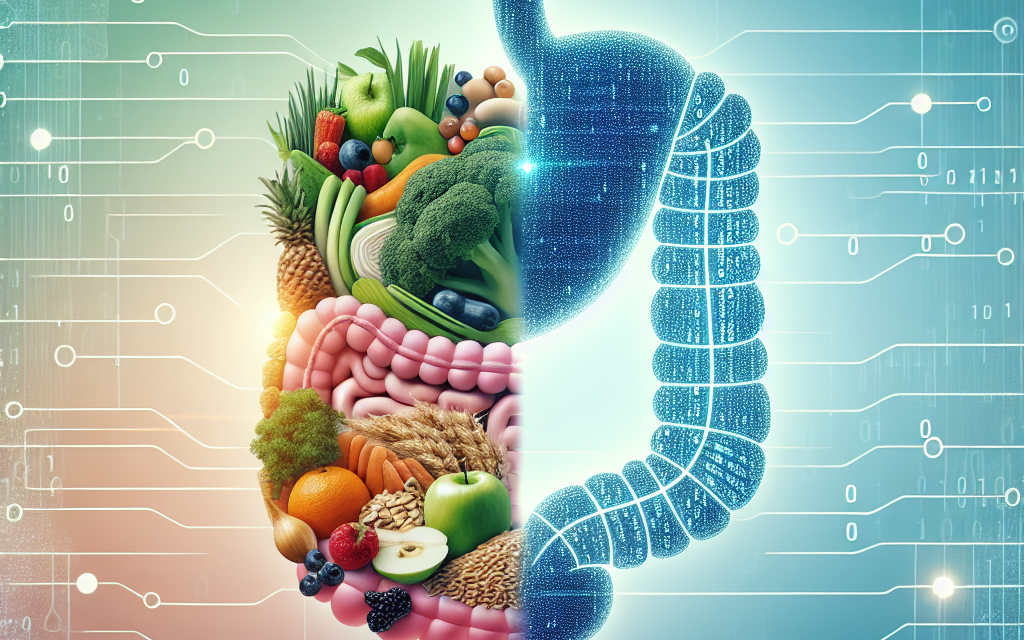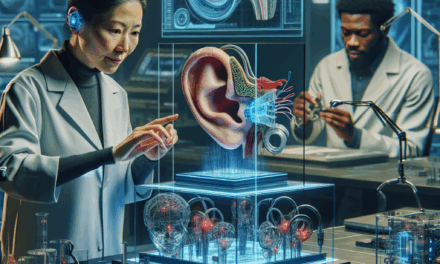Enhancing Digestive Health Through Technology

In recent years, the intersection of technology and health has opened new avenues for improving various aspects of human well-being, including digestive health. As digestive disorders become increasingly prevalent, the need for innovative solutions has never been more critical. This article explores how technology is revolutionizing digestive health, offering insights into the latest advancements and their implications for individuals and healthcare systems.
1. The Role of Wearable Technology in Digestive Health
Wearable technology has become a cornerstone in the health and wellness industry, providing real-time data and insights into various bodily functions. In the realm of digestive health, wearables are proving to be invaluable tools for monitoring and managing conditions.
1.1 Understanding Wearable Devices for Digestive Health
Wearable devices designed for digestive health typically include sensors that track physiological parameters such as heart rate, body temperature, and gastrointestinal activity. These devices can be worn on the wrist, abdomen, or even ingested in the form of smart pills.
For instance, smart pills equipped with sensors can travel through the digestive tract, collecting data on pH levels, temperature, and pressure. This information is then transmitted to a smartphone or computer, allowing healthcare providers to gain a comprehensive understanding of a patient’s digestive health.
1.2 Benefits of Wearable Technology
The primary advantage of wearable technology is its ability to provide continuous monitoring, which is crucial for managing chronic digestive conditions such as irritable bowel syndrome (IBS) and Crohn’s disease. By offering real-time data, wearables enable patients and healthcare providers to identify triggers and patterns, leading to more personalized treatment plans.
- Real-time monitoring of symptoms and triggers
- Personalized treatment plans based on data
- Improved patient engagement and adherence to treatment
1.3 Case Studies and Success Stories
Several case studies highlight the effectiveness of wearable technology in managing digestive health. For example, a study conducted by the Mayo Clinic found that patients using a wearable device to monitor their digestive symptoms experienced a 30% reduction in symptom severity over six months.
Another success story involves a patient with IBS who used a smart pill to identify specific food triggers. By avoiding these triggers, the patient reported a significant improvement in quality of life and a reduction in medication use.
1.4 Challenges and Limitations
Despite their potential, wearable devices for digestive health face several challenges. One major limitation is the accuracy of data collected by these devices, which can be affected by factors such as device placement and user compliance.
Additionally, the cost of wearable technology can be prohibitive for some patients, limiting accessibility. There is also a need for more extensive clinical trials to validate the efficacy of these devices in diverse populations.
1.5 Future Prospects
The future of wearable technology in digestive health looks promising, with ongoing research and development aimed at improving device accuracy and affordability. As technology advances, we can expect more sophisticated wearables that offer even greater insights into digestive health.
In conclusion, wearable technology is transforming the way we approach digestive health, offering new opportunities for monitoring and managing conditions. As these devices become more accessible and accurate, they have the potential to significantly improve patient outcomes and quality of life.
2. The Impact of Artificial Intelligence on Digestive Health
Artificial intelligence (AI) is reshaping the healthcare landscape, providing powerful tools for diagnosing and treating various conditions. In the field of digestive health, AI is being leveraged to enhance diagnostic accuracy, personalize treatment plans, and predict disease progression.
2.1 AI in Diagnostic Imaging
One of the most significant applications of AI in digestive health is in diagnostic imaging. AI algorithms can analyze medical images such as endoscopies and colonoscopies with remarkable accuracy, identifying abnormalities that may be missed by human eyes.
For example, AI-powered systems can detect polyps in colonoscopy images with a sensitivity and specificity comparable to experienced gastroenterologists. This capability not only improves diagnostic accuracy but also reduces the time required for image analysis.
2.2 Personalized Treatment Plans
AI is also being used to develop personalized treatment plans for patients with digestive disorders. By analyzing large datasets, AI can identify patterns and correlations that inform treatment decisions.
For instance, AI algorithms can predict how a patient will respond to a particular medication based on their genetic profile and medical history. This information allows healthcare providers to tailor treatment plans to individual patients, improving efficacy and reducing side effects.
2.3 Predictive Analytics for Disease Progression
Predictive analytics is another area where AI is making a significant impact. By analyzing patient data, AI can predict the progression of digestive diseases, allowing for early intervention and improved outcomes.
For example, AI models can predict the likelihood of a patient with inflammatory bowel disease (IBD) developing complications such as strictures or fistulas. This information enables healthcare providers to implement preventive measures and monitor patients more closely.
2.4 Case Studies and Real-World Applications
Several real-world applications demonstrate the potential of AI in digestive health. A study published in the journal Gastroenterology found that an AI system could accurately diagnose Barrett’s esophagus, a precursor to esophageal cancer, with a sensitivity of 94% and a specificity of 79%.
Another example is the use of AI to predict the risk of colorectal cancer recurrence. By analyzing data from over 1,000 patients, researchers developed an AI model that accurately predicted recurrence risk, allowing for more targeted follow-up care.
2.5 Challenges and Ethical Considerations
While AI offers significant benefits, it also presents challenges and ethical considerations. One major concern is the potential for bias in AI algorithms, which can arise from biased training data. Ensuring that AI systems are trained on diverse datasets is crucial to avoid perpetuating health disparities.
Additionally, the use of AI in healthcare raises questions about data privacy and security. Protecting patient data and ensuring transparency in AI decision-making processes are essential to maintaining trust in these technologies.
In summary, AI is revolutionizing digestive health by enhancing diagnostic accuracy, personalizing treatment plans, and predicting disease progression. As AI technology continues to evolve, it holds the promise of transforming the way we diagnose and treat digestive disorders.
3. Telemedicine and Remote Monitoring for Digestive Health
Telemedicine has emerged as a vital tool in healthcare, providing remote access to medical services and expertise. In the context of digestive health, telemedicine offers numerous benefits, including increased accessibility, convenience, and continuity of care.
3.1 The Rise of Telemedicine in Digestive Health
The COVID-19 pandemic accelerated the adoption of telemedicine, as healthcare providers sought to minimize in-person visits and reduce the risk of virus transmission. This shift has been particularly beneficial for patients with chronic digestive conditions who require regular monitoring and follow-up care.
Telemedicine platforms enable patients to consult with gastroenterologists and other specialists from the comfort of their homes. This convenience is especially valuable for individuals living in rural or underserved areas, where access to specialized care may be limited.
3.2 Remote Monitoring Technologies
Remote monitoring technologies complement telemedicine by allowing healthcare providers to track patients’ digestive health in real-time. These technologies include wearable devices, mobile apps, and connected home devices that collect data on symptoms, medication adherence, and lifestyle factors.
For example, a patient with IBD can use a mobile app to log symptoms, track medication use, and receive reminders for follow-up appointments. This data is then shared with their healthcare provider, enabling timely interventions and adjustments to treatment plans.
3.3 Benefits of Telemedicine and Remote Monitoring
The integration of telemedicine and remote monitoring offers several benefits for patients and healthcare providers:
- Improved access to specialized care
- Reduced travel time and costs for patients
- Enhanced patient engagement and self-management
- Timely interventions and adjustments to treatment plans
3.4 Case Studies and Success Stories
Numerous case studies highlight the effectiveness of telemedicine and remote monitoring in managing digestive health. A study published in the American Journal of Gastroenterology found that telemedicine consultations for patients with IBD resulted in similar clinical outcomes compared to in-person visits, with high patient satisfaction rates.
Another success story involves a patient with celiac disease who used a remote monitoring app to track dietary adherence and symptoms. By sharing this data with their healthcare provider, the patient was able to identify gluten exposure sources and improve symptom management.
3.5 Challenges and Future Directions
Despite its benefits, telemedicine faces challenges such as technology access disparities and regulatory hurdles. Ensuring that all patients have access to the necessary technology and internet connectivity is crucial to maximizing the reach of telemedicine services.
Looking ahead, the integration of telemedicine with other digital health technologies, such as AI and wearable devices, holds the potential to further enhance digestive health management. As these technologies continue to evolve, they will play an increasingly important role in delivering high-quality, patient-centered care.
In conclusion, telemedicine and remote monitoring are transforming the landscape of digestive health care, offering increased accessibility, convenience, and continuity of care. As these technologies become more integrated and accessible, they have the potential to significantly improve patient outcomes and quality of life.
4. The Role of Mobile Apps in Digestive Health Management
Mobile apps have become ubiquitous in modern life, offering a wide range of functionalities that cater to various needs. In the realm of digestive health, mobile apps are playing an increasingly important role in helping individuals manage their conditions and improve their overall well-being.
4.1 Types of Mobile Apps for Digestive Health
There are several types of mobile apps designed to support digestive health, each with its own unique features and benefits:
- Symptom Tracking Apps: These apps allow users to log symptoms, track their frequency and severity, and identify potential triggers.
- Dietary Management Apps: These apps help users plan meals, track food intake, and monitor adherence to specific dietary restrictions.
- Medication Management Apps: These apps provide reminders for medication use, track adherence, and offer information on potential side effects.
- Educational Apps: These apps offer information on digestive health conditions, treatment options, and lifestyle modifications.
4.2 Benefits of Mobile Apps for Digestive Health
Mobile apps offer several benefits for individuals managing digestive health conditions:
- Convenience: Mobile apps provide easy access to information and tools that support self-management.
- Personalization: Many apps offer personalized recommendations based on user data and preferences.
- Engagement: Apps encourage active participation in health management, leading to better adherence to treatment plans.
- Data Sharing: Apps facilitate data sharing with healthcare providers, enabling more informed decision-making.
4.3 Case Studies and Real-World Applications
Several case studies demonstrate the effectiveness of mobile apps in managing digestive health. A study published in the Journal of Medical Internet Research found that a mobile app designed for patients with IBS improved symptom management and quality of life over a 12-week period.
Another example involves a patient with lactose intolerance who used a dietary management app to track food intake and identify lactose-containing foods. By avoiding these foods, the patient reported a significant reduction in symptoms and improved overall well-being.
4.4 Challenges and Limitations
While mobile apps offer numerous benefits, they also face challenges and limitations. One major concern is the accuracy and reliability of the information provided by these apps. Ensuring that apps are evidence-based and developed in collaboration with healthcare professionals is crucial to maintaining their credibility.
Additionally, user engagement and adherence can be challenging, as individuals may lose interest in using the app over time. Designing apps that are user-friendly and engaging is essential to maintaining long-term use.
4.5 Future Prospects
The future of mobile apps in digestive health looks promising, with ongoing advancements in app development and integration with other digital health technologies. As apps become more sophisticated and personalized, they have the potential to play an even greater role in supporting individuals with digestive health conditions.
In summary, mobile apps are transforming the way individuals manage their digestive health, offering convenient and personalized tools for self-management. As these apps continue to evolve, they hold the promise of improving patient outcomes and quality of life.
5. The Potential of Gut Microbiome Analysis in Digestive Health
The gut microbiome, a complex community of microorganisms residing in the digestive tract, plays a crucial role in maintaining digestive health. Advances in technology have made it possible to analyze the gut microbiome in unprecedented detail, offering new insights into its impact on health and disease.
5.1 Understanding Gut Microbiome Analysis
Gut microbiome analysis involves sequencing the DNA of microorganisms present in the digestive tract to identify their composition and abundance. This information provides valuable insights into the diversity and balance of the microbiome, which can influence various aspects of health.
For example, an imbalance in the gut microbiome, known as dysbiosis, has been linked to several digestive disorders, including IBS, IBD, and celiac disease. By analyzing the microbiome, researchers can identify specific microbial patterns associated with these conditions.
5.2 Applications of Gut Microbiome Analysis
Gut microbiome analysis has several applications in digestive health:
- Diagnosis: Microbiome analysis can aid in the diagnosis of digestive disorders by identifying microbial patterns associated with specific conditions.
- Personalized Treatment: By understanding an individual’s microbiome composition, healthcare providers can develop personalized treatment plans that target specific microbial imbalances.
- Prevention: Microbiome analysis can identify individuals at risk of developing digestive disorders, allowing for early intervention and preventive measures.
5.3 Case Studies and Real-World Applications
Several case studies highlight the potential of gut microbiome analysis in digestive health. A study published in the journal Nature found that microbiome analysis could accurately predict the onset of IBD in at-risk individuals, allowing for early intervention and improved outcomes.
Another example involves a patient with IBS who underwent microbiome analysis to identify specific microbial imbalances. By targeting these imbalances with dietary modifications and probiotics, the patient reported a significant improvement in symptoms and quality of life.
5.4 Challenges and Limitations
Despite its potential, gut microbiome analysis faces several challenges and limitations. One major challenge is the complexity of the microbiome, which can vary significantly between individuals and over time. This variability makes it difficult to establish standardized reference ranges for microbial composition.
Additionally, the interpretation of microbiome data requires specialized expertise, and the clinical applications of microbiome analysis are still being explored. More research is needed to fully understand the implications of microbiome composition for digestive health.
5.5 Future Prospects
The future of gut microbiome analysis in digestive health looks promising, with ongoing research aimed at uncovering the complex interactions between the microbiome and host health. As our understanding of the microbiome deepens, it holds the potential to revolutionize the diagnosis, treatment, and prevention of digestive disorders.
In conclusion, gut microbiome analysis offers valuable insights into the complex interactions between microorganisms and host health, with significant implications for digestive health. As technology continues to advance, microbiome analysis holds the promise of transforming the way we approach digestive health care.
Conclusion
The integration of technology into digestive health care is transforming the way we diagnose, monitor, and manage digestive disorders. From wearable devices and artificial intelligence to telemedicine, mobile apps, and gut microbiome analysis, these technological advancements offer new opportunities for improving patient outcomes and quality of life.
As these technologies continue to evolve, they hold the promise of revolutionizing digestive health care, offering more personalized, accessible, and effective solutions for individuals with digestive disorders. By embracing these innovations, we can enhance our understanding of digestive health and pave the way for a healthier future.





